Transcription of Overview of food fraud in the fisheries sector - fao.org
1 FAO fisheries and Aquaculture Circular FIAM/C1165 (En) ISSN 2070-6065 Overview OF FOOD fraud IN THE fisheries sector Cover photo: Mussel farm in the Philippines. FAO/A. Reilly. FAO fisheries and Aquaculture Circular No. 1165 FIAM/C1165 (En) Overview OF FOOD fraud IN THE fisheries sector Alan Reilly Consultant fisheries and Aquaculture Policy and Resources Division Food and Agriculture Organization FOOD AND AGRICULTURE ORGANIZATION OF THE UNITED NATIONS Rome, 2018 The designations employed and the presentation of material in this information product do not imply the expression of any opinion whatsoever on the part of the Food and Agriculture Organization of the United Nations (FAO)
2 Concerning the legal or development status of any country, territory, city or area or of its authorities, or concerning the delimitation of its frontiers or boundaries. The mention of specific companies or products of manufacturers, whether or not these have been patented, does not imply that these have been endorsed or recommended by FAO in preference to others of a similar nature that are not mentioned. The views expressed in this information product are those of the author(s) and do not necessarily reflect the views or policies of FAO.
3 ISBN 978-92-5-130402-0 FAO, 2018 FAO encourages the use, reproduction and dissemination of material in this information product. Except where otherwise indicated, material may be copied, downloaded and printed for private study, research and teaching purposes, or for use in non-commercial products or services, provided that appropriate acknowledgement of FAO as the source and copyright holder is given and that FAO s endorsement of users views, products or services is not implied in any way. All requests for translation and adaptation rights, and for resale and other commercial use rights should be made via or addressed to FAO information products are available on the FAO website ( ) and can be purchased through iii PREPARATION OF THIS DOCUMENT Food fraud , while not a new phenomenon, has come under the spotlight in recent years.
4 Following on from the 2013 horsemeat scandal in the European Union, which exposed the vulnerability of international food chains to fraud and organised crime, major initiatives are under way by many governments and within the industry to combat food fraud . FAO is following this situation carefully and is engaged in a number of activities to contribute to the preparedness for countries to prevent food fraud or to mitigate its impacts. FAO is particularly concerned with the provision of information and analyses that inform policies and programmes across sectors and in raising awareness in developing countries of the issue and its relevance to them.
5 The fisheries and aquaculture sectors are recognised as among the most vulnerable sectors to food fraud . FAO commissioned Professor Alan Reilly, former Chief Executive Officer of the Food Safety Authority of Ireland, to write this review of fraud in the fisheries and aquaculture sectors and provide recommendations for future actions. This circular was funded through FAO's Strategic Programme of work on "efficient and inclusive food systems", and was implemented jointly by the Agriculture and Consumer Protection Department and the fisheries and Aquaculture Department.
6 Iv FAO. 2018. Overview of food fraud in the fisheries sector , by Alan Reilly. fisheries and Aquaculture Circular No. 1165. Rome, Italy. ABSTRACT Fish fraud is committed when fish is illegally placed on the market with the intention of deceiving the customer, usually for financial gain. However, its precise scale and nature in the wider global food market is largely unknown. This publication presents evidence highlighting the serious consequences of fraud for the fish sector . It describes the different types of fraud that can take place along the fish supply chain, for example: intentional mislabelling, species substitution, overglazing and overbreading, and the use of undeclared water-binding agents to increase weight.
7 This publication shows that combating fish fraud is a complex task that requires the strengthening of national food regulatory programmes and the development of effective, science-based traceability systems and improved methods for fish authenticity testing. It highlights the need for the fish industry to develop and implement systems for fish fraud vulnerability assessment in order to identify potential sources of fish fraud within their supply chains, and to prioritize control measures to minimize the risk of receiving fraudulent or adulterated raw materials or ingredients.
8 The publication also indicates an important role for the Codex Alimentarius Commission to work in collaboration with countries in order to develop international principles and guidelines designed to identify, manage and mitigate fraudulent practices in food trade and to develop guidelines to standardize food safety management systems for fish fraud vulnerability assessment. v CONTENTS Preparation of this document .. iii Abbreviations and acronyms .. vi Executive Summary .. vii 1. Introduction .. 1 2. Fish fraud .
9 2 3. Scale and global incidence of fish fraud .. 4 4. Public health aspects of fish fraud .. 7 5. DNA Barcoding .. 9 6. Illegal, Unreported and Unregulated Fishing and Fish fraud .. 12 7. Mitigation of fish fraud at national level .. 13 Establishing an agreed list of fish names .. 13 Mandatory labelling requirements .. 14 Strengthening official food controls .. 14 Strengthening industry food safety management systems .. 14 8. Conclusions .. 16 9. References .. 17 vi ABBREVIATIONS AND ACRONYMS DNA deoxyribonucleic acid CO1 cytochrome oxidase subunit 1 EC European Commission EU European Union Europol European Union Agency for Law Enforcement Cooperation FISH-BOL Fish Barcode of Life HACCP Hazard Analysis and Critical Control Points INTERPOL International Criminal Police Organization IUU illegal, unreported and unregulated (fishing)
10 MSC Marine Stewardship Council TACCP Threat Assessment and Critical Control Points USFDA United States Food and Drug Administration USP United States Pharmacopeial Convention vii EXECUTIVE SUMMARY Food fraud is committed when food is illegally placed on the market with the intention of deceiving the customer, usually for financial gain. This involves criminal activity that can include food mislabelling, substitution, counterfeiting, misbranding, dilution and adulteration. While food fraud primarily results in cheating customers, it can also lead to significant food safety risks for consumers.
















